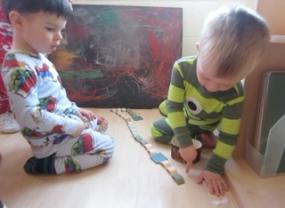Pajama Count

Lincoln and Golden, two toddlers, are working to arrange tiles on the floor and count them. Golden uses strategies to help him count effectively. The boy locates the first tile in the series to begin counting (00:03). Golden tries to say one number word for each tile he points to but does not point to the sixth tile, saying "six" on the seventh when pointing to the seventh. He has the right idea but his hand just gets ahead of the count. Then he double counts the eighth tile after bumping it and coincidently gets back on an accurate count. Then he points the space between tile 9 and 10 saying "ten" thereby calling tile 10 "eleven." With slightly better precision he finished his count on "twenty three." He knows the number sequence but has a little trouble timing his points with his words. We are not sure why he does not correct his skip counts and double counts. Does he know that bowing to this one-word-per-tile procedure is necessary to get the same cardinal value every time you count? Perhaps not. Golden says, “Okay,” to signal he has finished counting the tiles (00:22). Note that he does not stress the last number counted (23). He may not yet have an understanding cardinality - the last number counted tells you the total number of items (tiles) in the set. Lincoln (striped pajamas) closes the gaps between individual tiles (00:14-00:30), causing the line to curve. Golden objects and rearranges the tiles in linear fashion (00:33). Organizing the tiles is a strategy to help him avoid skipping over, or counting the same tile more than once. Lincoln alerts Golden that a few tiles are omitted, showing he senses that the tiles are lined up to help them count (01:10). Lincoln also points as he counts, but from a distance without trying to match one point per tile even though he matches one word per point. (01:20-01:25). Lincoln does not yet link the number words to the individual tiles, but rather to the action of pointing. One can conclude Golden is a bit further along than Lincoln on what this motor ritual should yield. Most young children view ten as a big number and Lincoln likely intends to convey that they have a lot of tiles when he exclaims, “Oh, we have ten of them!” (01:26). Lincoln knows that the last number word describes the total number of items in the set. However, he holds up five fingers (01:27) when he says "ten" suggesting he does not know how to represent ten using both hands. Golden holds out ten fingers in reply. Maybe Lincoln wanted to end on ten as a favorite number and made his count bow to his intention instead of letting a more precise count yield the cardinal value. What do you make of the fact that the boys were not surprised that their two counts of the same tiles yielded such widely different numbers? Length of video: 1 minute 56 seconds Keywords: Twos, Children-Object, Math, Counting, One-to-One Correspondence, Cardinal Number, Collaboration
